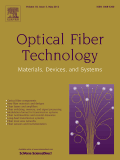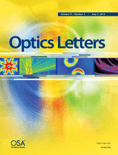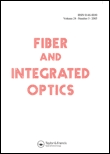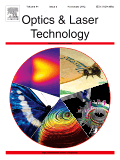
Acta Photonica Sinica
Scope & Guideline
Empowering Research in Light and Matter
Introduction
Aims and Scopes
- Photonics Technology and Applications:
The journal covers various technologies related to photonics, including lasers, optical sensors, imaging systems, and optical communication, emphasizing their applications in diverse fields such as telecommunications, medical diagnostics, and environmental monitoring. - Nanophotonics and Metamaterials:
Research on nanostructured materials and metamaterials is a significant focus, investigating their unique optical properties and potential applications in areas such as sensing, imaging, and information processing. - Optical Sensing and Measurement:
The journal places a strong emphasis on optical sensing technologies, including fiber optics and photonic sensors, aimed at developing high-precision measurement techniques for various physical and chemical parameters. - Theoretical and Computational Photonics:
Theoretical studies and computational modeling related to light-matter interactions, wave propagation, and optical system design are critical components, providing insights into fundamental physics and guiding experimental research. - Interdisciplinary Research:
Acta Photonica Sinica encourages interdisciplinary studies that integrate photonics with fields like biology, chemistry, and materials science, fostering innovations that leverage optical technologies for novel applications.
Trending and Emerging
- Machine Learning and AI in Photonics:
The integration of machine learning and artificial intelligence into photonics research is increasingly prominent, with studies focusing on optimizing optical systems, enhancing image processing, and automating data analysis. - Quantum Photonics:
Research in quantum photonics is on the rise, exploring applications in quantum information science, quantum communication, and quantum sensing, reflecting the growing interest in harnessing quantum phenomena for technological advancements. - Sustainable and Green Photonics:
There is a notable trend towards research in sustainable photonic technologies, including energy-efficient photonic devices and materials, as well as applications in environmental monitoring and renewable energy. - Advanced Photonic Materials:
Emerging research on novel photonic materials, including 2D materials and hybrid systems, is gaining momentum, focusing on their unique optical properties and potential applications in next-generation photonic devices. - Biomedical Applications of Photonics:
The application of photonics in biomedicine is rapidly expanding, with increased research on optical imaging techniques, phototherapy, and biosensing technologies, driven by the demand for innovative healthcare solutions.
Declining or Waning
- Traditional Optical Imaging Techniques:
There has been a noticeable decline in publications focused solely on conventional imaging techniques as researchers increasingly explore advanced imaging modalities, such as hyperspectral imaging and computational imaging. - Basic Laser Physics:
Research centered on fundamental aspects of laser physics appears to be waning, with a shift towards practical applications and technological advancements in laser systems, indicating a move away from purely theoretical studies. - Low-tech Optical Sensing Solutions:
Papers focusing on basic optical sensing technologies without novel enhancements or applications have decreased, as the field moves towards more sophisticated and integrated sensing solutions.
Similar Journals

OPTICAL FIBER TECHNOLOGY
Illuminating Pathways in Optical and Electronic EngineeringOPTICAL FIBER TECHNOLOGY is a premier journal in the fields of atomic and molecular physics, optics, control and systems engineering, as well as electrical and electronic engineering, published by ELSEVIER SCIENCE INC. With an ISSN of 1068-5200 and E-ISSN 1095-9912, it offers a platform for disseminating cutting-edge research and developments in optical fiber technology and its applications. The journal has achieved a notable impact, ranking in the second quartile for multiple categories in 2023, including control and systems engineering and electronic, optical, and magnetic materials. By providing a robust avenue for peer-reviewed articles, OPTICAL FIBER TECHNOLOGY caters to a diverse audience of researchers, professionals, and students dedicated to advancing knowledge and innovation in optics and related fields. This respected journal is particularly suited for those seeking to stay updated on the latest technological advancements and research trends, ensuring its relevance in both academic and industrial contexts.

JOURNAL OF RUSSIAN LASER RESEARCH
Pioneering Research in Optics and EngineeringThe Journal of Russian Laser Research, published by Springer, stands as a vital resource for researchers and professionals in the fields of atomic and molecular physics, as well as optics and engineering. With its ISSN 1071-2836 and E-ISSN 1573-8760, this journal has been disseminating groundbreaking research since its inception in 1994, with a dedicated focus on the advancement of laser technologies and their applications. While it currently holds a Q4 classification in both Atomic and Molecular Physics and Engineering categories, its commitment to fostering novel insights and innovative methodologies positions it as a promising platform for emerging studies within these disciplines. Although the journal does not offer open access options, it continues to draw attention with a growing citation index. By publishing diverse research articles, reviews, and critical discussions, the Journal of Russian Laser Research not only enriches academic literature but also serves as a stepping stone for students and professionals seeking to deepen their understanding of laser science and its myriad applications.

Opto-Electronic Advances
Advancing the Frontiers of Opto-ElectronicsOpto-Electronic Advances is a premier open-access journal published by the Chinese Academy of Sciences' Institute of Optics & Electronics, dedicated to advancing the fields of optics and electronic engineering. Established in 2018, this journal quickly ascended to a Q1 ranking across multiple categories including Atomic and Molecular Physics, Electrical and Electronic Engineering, and Electronic, Optical and Magnetic Materials, showcasing its impact and relevance in the scientific community. With an impressive Scopus ranking placing it in the top percentiles for critical fields such as Engineering, Materials Science, and Physics, Opto-Electronic Advances provides a platform for researchers to publish their cutting-edge findings and foster dialogue in an increasingly interdisciplinary area of study. The journal emphasizes innovative research that contributes to practical applications and theoretical frameworks in its domain, making it an invaluable resource for academicians, industry practitioners, and students alike. Embrace the future of opto-electronic research with Opto-Electronic Advances, which has been fully open access since 2021, ensuring that knowledge is widely disseminated without barriers.

OPTICS LETTERS
Your Gateway to High-Impact Optical DiscoveriesOPTICS LETTERS is a premier academic journal published by the Optica Publishing Group, dedicated to advancing the field of optics and photonics. Since its inception in 1977, it has maintained a strong reputation for publishing high-impact research, holding a distinguished Q1 category ranking in Atomic and Molecular Physics, as well as Optics, making it a vital resource for researchers and professionals alike. With an impressive Scopus rank of #55 out of 224 in its field, OPTICS LETTERS continues to shape the discourse and innovation in optical science. Authors benefit from its extensive international reach, while readers gain access to cutting-edge studies that address both theoretical and applied aspects of optics. Although the journal currently does not offer open access options, its rigorous peer-review standards ensure that every publication meets the highest academic criteria, making it an essential journal for anyone looking to stay at the forefront of optical research.

Computer Optics
Pioneering Insights in Optics Through Computational ExcellenceComputer Optics is a prominent academic journal dedicated to advancing the field of optics and its integration with computer science, published by the IMAGE PROCESSING SYSTEMS INST of the Russian Academy of Sciences. With an ISSN of 0134-2452 and an E-ISSN of 2412-6179, this journal has been a vital resource for researchers and professionals since it became Open Access in 1987, promoting the free dissemination of knowledge. Based in Samara, Russia, Computer Optics covers a broad range of relevant topics, with its scope spanning atomic and molecular physics, optics, computer vision, and electrical engineering. Although characterized within Q4 and Q3 quartiles in various categories in 2023, its rigorous peer-review process ensures the publication of high-quality research contributions. The journal is crucial for those wishing to explore interdisciplinary approaches that merge practical applications of optics with cutting-edge computer technologies, thereby acting as a bridge between these dynamic fields.

Optics
Transforming Ideas into Light: Your Source for Optical ResearchOptics is a pioneering open access journal published by MDPI, dedicated to advancing the field of optics and photonics. Since its inception in 2020, the journal has fostered the dissemination of high-quality research and innovative developments in optical sciences, contributing significantly to its community of researchers, professionals, and students in Switzerland and beyond. With an impact factor reflective of its growing prominence, Optics strives to address a diverse scope, encompassing atomic and molecular physics, electronic materials, and broader topics in physics and astronomy. The journal's commitment to open access ensures that cutting-edge research is freely available, promoting collaboration and knowledge-sharing across disciplines. As of 2023, it holds a Q4 ranking in several categories, including Atomic and Molecular Physics, and Optics, which illustrates its evolving role in the academic landscape, positioning it as a valuable resource for those seeking to explore the frontiers of optical technology and its applications.

FIBER AND INTEGRATED OPTICS
Pioneering Insights in Optical and Fiber SciencesFIBER AND INTEGRATED OPTICS is a prominent academic journal published by TAYLOR & FRANCIS INC, focusing on the cutting-edge domains of optical and fiber technologies. Since its inception in 1977, the journal has journeyed through expansive developments in the fields of Atomic and Molecular Physics, as well as Electronic, Optical, and Magnetic Materials, boasting a converged publication history extending to 2024. With a solid reputation reflected in its Q3 rankings in both aforementioned categories, FIBER AND INTEGRATED OPTICS serves as an essential platform for researchers, professionals, and students to disseminate and explore innovative findings and methodologies. Although currently not offering Open Access, its scholarly contributions remain invaluable, fostering a deeper understanding and advancements in fiber optic applications and integrated optical systems. Situated in the United Kingdom, the journal continues to attract a diverse global audience, solidifying its significance in contemporary scientific discourse.

APPLIED PHYSICS B-LASERS AND OPTICS
Shaping the Landscape of Optical ScienceApplied Physics B - Lasers and Optics, published by Springer Heidelberg, is a renowned journal in the field of applied physics, particularly focusing on lasers and optical technologies. With a solid impact factor, this journal has established itself as a significant source of cutting-edge research, contributing to advancements in both theoretical and practical aspects of the discipline. The journal is indexed in Scopus, boasting a commendable rank of #24 out of 81 in the category of Physics and Astronomy (miscellaneous), reflecting its reputation and the quality of published work. Since its inception in 1994, Applied Physics B has covered a wide array of topics, catering to researchers, professionals, and students engaged in the exploration of innovative optical phenomena and laser applications. This journal not only disseminates vital knowledge but also fosters interdisciplinary collaboration, making it an essential resource for those seeking to stay at the forefront of research in lasers and optics.

ACTA OPTICA SINICA
Fostering Insights in Electronic and Optical MaterialsACTA OPTICA SINICA is a distinguished journal dedicated to the field of optics and photonics, published by the Chinese Laser Press. With an ISSN of 0253-2239, this journal has been an essential resource since its inception, covering significant discoveries and advancements in atomic and molecular physics, electronic materials, and optical sciences. The journal is indexed in Scopus, achieving respectable ranks as Q3 in both Atomic and Molecular Physics, and Optics and Electronic, Optical and Magnetic Materials, reflecting its engagement with current research trends. Although it is not an open-access journal, ACTA OPTICA SINICA is hosted from Shanghai, China, and continues to serve as a vital platform for researchers, professionals, and students alike to disseminate and access high-quality peer-reviewed articles, ensuring its prominent place in the academic discourse related to optics and material sciences.

OPTICS AND LASER TECHNOLOGY
Exploring the Frontiers of Optical ScienceOPTICS AND LASER TECHNOLOGY, published by Elsevier Science Ltd, is a premier journal dedicated to advancing knowledge in the fields of optics and laser applications. With its impressive Q1 rankings across three critical categories—Atomic and Molecular Physics, and Optics; Electrical and Electronic Engineering; and Electronic, Optical and Magnetic Materials—the journal stands at the forefront of scientific discourse, boasting a significant impact factor that underscores its relevance. Since its inception in 1970, the journal has consistently provided a platform for the dissemination of cutting-edge research, key innovations, and reviews that influence both academic study and practical applications. Although it currently does not have open access options, its rigorous peer-review process and inclusion in esteemed indexing services make it a valuable resource for researchers, professionals, and students seeking to stay informed about the latest developments in optics and laser technology. The journal’s ongoing commitment to quality research ensures it remains a vital publication for those engaged in this dynamic field, with a converged projection extending through 2025.